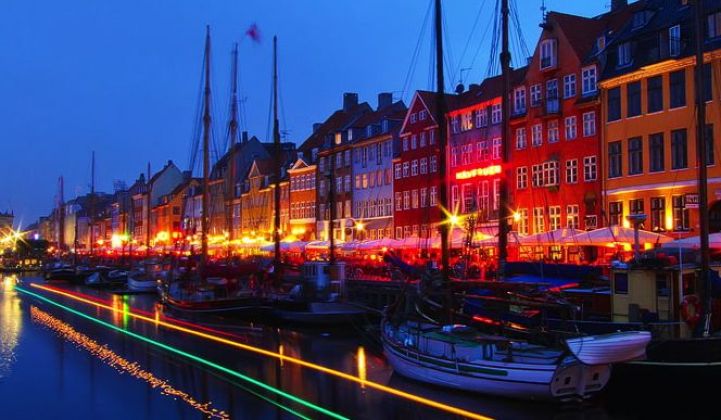Silver Spring Networks (SSNI) has just landed the largest project yet for its push into city street lights as the next wireless networking frontier. On Monday, the smart grid networking company announced plans to connect 20,000 street lights in Denmark’s capital city of Copenhagen, with the first deployments set to begin next year.
Silver Spring will be working with French city lighting and electrical systems giant Citelum on the project, which envisions linking LED lamps from multiple manufacturers in a single networking platform. The goal, as with many LED streetlighting projects, is to link the energy efficiency and long life of LEDs with the additional control and intelligence that can come from connecting these digital light sources into a broader network.
Once that citywide network is in place, “it can easily be adapted to different applications, without having to invest a ton of R&D effort,” Sterling Hughes, Silver Spring’s senior director of advanced technology, said in a Monday phone interview. In other words, while networked LEDs are today’s cost-effective business case for getting a wireless mesh network installed across a city, they’re also “one of the first applications of the smart city,” he said.
“The fact that this is a citywide network canopy really makes it easy to have these follow-on options,” he said. “To us, lighting just looks like another sensor on the network.” While Silver Spring, Citelum and Copenhagen haven’t specified what other city equipment or devices might be linked up, options like traffic signals, parking meters -- or, perhaps, water, gas and electric meters -- could be future targets.
This concept of turning single-use networks into multi-use canopies aligns well with Silver Spring’s master plan for capturing new markets. The Redwood City, Calif.-based company went public in March on the strength of its large-scale smart metering projects with big U.S. utilities, but it’s been pushing to expand into distribution grid sensors and controls, demand response and home energy management devices, and other smart systems at the edge of the grid.
Silver Spring is already working on a networked street light and traffic signal pilot project in Paris, and has named streetlights as one of its target applications in its projects with San Antonio, Texas municipal utility CPS Energy, as well as with partners in Singapore and Malaysia. But its Copenhagen project represents the first time it’s been tapped to take its platform to a citywide context.
In preparation, Silver Spring has spent the past year or so building partnerships with specialists in the field, Hughes said. Those include streetlight control software maker Streetlight.Vision, Canadian LED retrofit module-maker LED Roadway Lighting, Irish streetlight controls system maker SELC and U.S. lighting sensor and photocontrol device maker Sunrise Technologies.
Partnerships like these are important to make sure that the network being installed can treat LED street lights like the digital control systems they are, he said. For example, knowing whether a light’s out because the LED itself has failed, or because the electricity circuit that’s powering it has gone out, is critical to effectively dispatching service workers to fix it, he said.
Beyond that, “The benefit to having a communication system that works better, from a diagnostics perspective, really comes from trending and analytics,” he said. As with smart grid systems, collecting a wide range of fifteen-minute interval data from these networked sensors can provide the depth of information required to diagnose network problems, to predict which lights are about to fail and replace them before they do, or to analyze which streets can have their lights turned down to save energy during which times of the day and/or year, based on pedestrian and vehicle traffic patterns, to name a few examples.
Silver Spring joins a host of smart grid networking companies seeking to expand their range of services into street lights and other “smart city” nodes. San Jose, Calif.-based smart grid networking company Echelon has been connecting streetlights via the company’s powerline carrier (PLC) technology, now in use by lighting companies like Philips and Osram, and smart meter players like Sensus and ABB’s Tropos Networks have been adding streetlights to the list of devices they’re connecting in citywide wireless networks.
Meanwhile, would-be smart city kingpins, such as IBM, Cisco, Schneider Electric, Siemens, Hitachi, Toshiba and General Electric, have been connecting street lights, traffic signals, parking monitor devices and other street-level equipment in smart city projects around the world. Still, while many of these “city of the future” type projects are quite impressive in their vision, it’s not always clear just how they’re going to deliver short-term cost savings and generate ongoing efficiencies in a way that will drive big investments.
Certainly LED street light replacements, with their easily calculated upfront energy and maintenance cost reductions, are a “no-brainer” step in that direction -- and thus, they’ve become a major target of the smart city crowd. That means that the still-nascent smart streetlighting market is set for big growth. Navigant Research predicts that today’s roster of a few hundred integrated projects and about 500,000 smart LED nodes shipped last year will see a major increase by 2020, increasing to 1,100 projects and 4.8 million communications nodes shipped.
Why is it interesting to network street lights? Silver Spring Networks hosted a webinar on just this topic:



